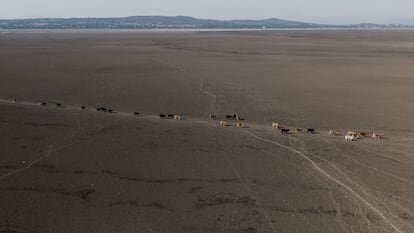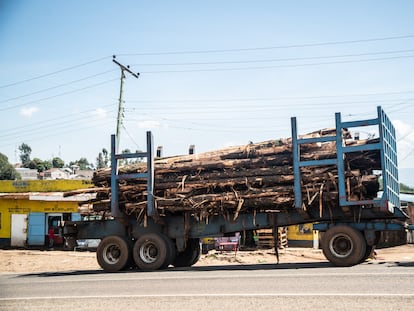‘Climate solutions’ for Latin America to overcome the challenge of adapting to the environmental crisis
The latest CAF report proposes global measures on how to mitigate warming and seek solutions in nature


The world our grandparents knew bears little or no resemblance to today. If climate change was mentioned then, it was almost in the form of a myth; the monster under the bed. Today it is such a tangible reality that it is truly frightening. In Latin America, one of the regions of the world that emits the fewest greenhouse gases, extreme weather events increased from an average of 28 per year between 1980 and 1999 to 53 per year over the last two decades, affecting almost 3 million more people. Deforestation, biodiversity loss, and rising sea levels highlight two realities: that the world has changed and it is time to adapt to it, and that global commitments are increasingly urgent.
“Adapting allows for several measures at once,” explains Ricardo Estrada, one of the authors of the latest Economy and Development Report (RED) issued by CAF — Development Bank of Latin America and the Caribbean. “An adaptation measure can bring with it impact mitigation and local development tools. For example, the promotion of mangrove barriers against sea level rise is a conservation policy that also fulfills the function of mitigation. It can generate local economic development and, at the same time, provide security to the investor,” he adds. In the absence of such precautions, climate change could cause between 2.4 million and 5.8 million people in Latin America and the Caribbean to fall into extreme poverty by 2030. “We know that this is a region with many unresolved problems and meager growth, but it is also a region that has many resources to find solutions,” adds the report’s co-author, Ernesto Schargrodsky.
The RED, presented Thursday in Santa Marta, on Colombia’s Caribbean coast, scans the continent and takes a snapshot of the region today to predict what the coming years will bring. The study indicates that the average temperature until 2040 will be about 1° C higher than between 1985 and 2014. Less rainfall is also expected in northern Latin America, the Caribbean, Central America, part of the Amazon, northeastern Brazil, central and southern Chile, and southern Argentina. This will result, the report says, in arid climates throughout the continent, with the exception of the coasts of Peru and Ecuador.
“The countries need, first of all, better diagnoses of what is happening in their territory,” says Pablo Brassiolo, co-author of the study, entitled “Global challenges, regional Solutions: Latin America and the Caribbean facing the climate and biodiversity crisis.” “The figures we saw show the difference in the impact of climate change. It is different depending on where you live and what you do for a living. Public policies have to take these differences into account.”
In Colombia, for example, there is high awareness of how climate change affects the population. Nine out of 10 Colombians are demanding stricter climate policies, according to a survey by the European Investment Bank, published Monday. Ninety-four percent of Colombians say they feel the effects of climate change in their daily lives, and 67% say it affects them considerably.

‘This reality is affecting us all’
“With this publication we want to highlight that it is necessary to integrate these policies with those that promote economic growth and social inclusion, which can give rise to complementarities and tensions that need to be managed articulately,” said Sergio Díaz-Granados, CAF’s executive president, at the presentation. “The world needs climate, food, and social solutions urgently. This reality is affecting us all.”
With a land area representing 16% of the world’s total, the region is home to an enormous variety of the world’s known species: 33% of mammals, 35% of reptiles, 41% of birds and 50% of amphibians. In the world’s most environmentally rich region, experts say, why not look to nature for solutions?
This type of adaptation strategy includes sustainable agricultural practices, which also tend to be cost-effective, and actions as varied as the restoration and conservation of natural cover, the recovery of coastal ecosystems, the development of urban green spaces or the use of natural barriers, such as those mentioned by Estrada. Together with Africa, the region has the highest proportion of nature-based adaptation initiatives.
For these measures to prosper, however, climate finance needs to be rethought. Nearly all current investment is allotted to mitigation projects, with less than 10% devoted to adaptation, despite the fact that around $70 billion a year is needed for 58 countries alone to adapt to global warming. The low investment in this portfolio is due to the fact that financing is subordinated to credits and to the financial profitability of the projects, which do not usually generate adaptation measures in the same way. “Developed countries, which usually contribute the most funds, do not bet on adaptation because the greatest benefit is local and stays in the communities,” says Brassiolo.
The star example of these alternatives is the carbon market. Experts cite Mexico and Colombia as examples, two countries that apply taxes on the use of some types of fossil fuels, but allow companies to substitute the payment of the tax partially or totally via the purchase of these bonds. “What has to be shielded, also with legislation, is that these spaces are truly conserved thanks to this payment,” Brassiolo says. “If the forest for which certain emissions are being compensated could have been reforested without the financing, it will not be an effective measure.”
Another big challenge, according to the three experts, is to eliminate energy price subsidies, which, they estimate, account for 1% of regional GDP. “It is probably an unpopular measure, but a necessary one. This is what the energy transition is all about,” Brassiolo adds. The key, he asserts, is robust governance that prioritizes the 2030 Agenda.
The RED presentation followed the Finance in Common Summit held in Cartagena de Indias, Colombia, from September 4-6. The event brought together development banks from around the world, which have played a crucial role in the fight against poverty and climate change. “We development banks do not have to compete with each other, but rather create an ecosystem from which Latin Americans benefit,” said Carolina España, CAF’s executive vice president. “The roadmap is clear: global challenges, regional solutions,” concluded Schargrodsky.
Sign up for our weekly newsletter to get more English-language news coverage from EL PAÍS USA Edition
Tu suscripción se está usando en otro dispositivo
¿Quieres añadir otro usuario a tu suscripción?
Si continúas leyendo en este dispositivo, no se podrá leer en el otro.
FlechaTu suscripción se está usando en otro dispositivo y solo puedes acceder a EL PAÍS desde un dispositivo a la vez.
Si quieres compartir tu cuenta, cambia tu suscripción a la modalidad Premium, así podrás añadir otro usuario. Cada uno accederá con su propia cuenta de email, lo que os permitirá personalizar vuestra experiencia en EL PAÍS.
¿Tienes una suscripción de empresa? Accede aquí para contratar más cuentas.
En el caso de no saber quién está usando tu cuenta, te recomendamos cambiar tu contraseña aquí.
Si decides continuar compartiendo tu cuenta, este mensaje se mostrará en tu dispositivo y en el de la otra persona que está usando tu cuenta de forma indefinida, afectando a tu experiencia de lectura. Puedes consultar aquí los términos y condiciones de la suscripción digital.
More information
Archived In
Últimas noticias
Welcome to the post-religion era: The idea of Christianity as the absolute truth has become obsolete
‘I thought you would like it’: The risky sexual practice popularized by TV shows and TikTok
The digitalization of tourism: ‘They promise experiences and gave us the worst possible one’
Mexican peso defies uncertainty with forecasts of a new period of stability in 2026
Most viewed
- Sinaloa Cartel war is taking its toll on Los Chapitos
- Oona Chaplin: ‘I told James Cameron that I was living in a treehouse and starting a permaculture project with a friend’
- Reinhard Genzel, Nobel laureate in physics: ‘One-minute videos will never give you the truth’
- Why the price of coffee has skyrocketed: from Brazilian plantations to specialty coffee houses
- Silver prices are going crazy: This is what’s fueling the rally










































